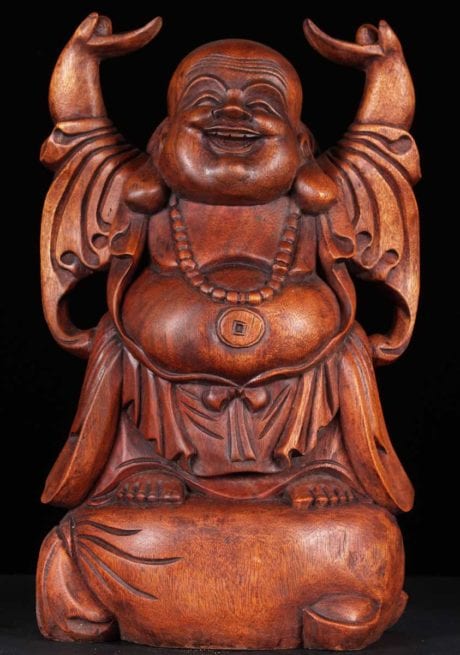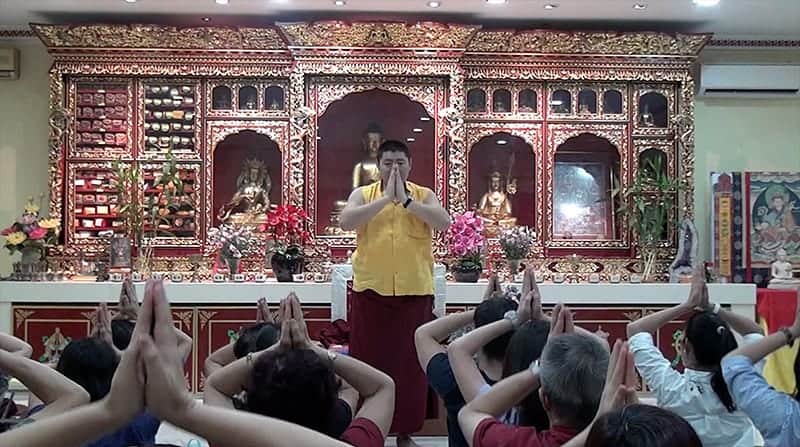Shaking Off Tiredness
Shaking off tiredness is an important technique for meditators to learn. Often we rise early to meditate and we may not be fully alert. Or, we may have worked hard all day and be exhausted when we start to sit. Dullness is one of the major obstacles faced by practitioners. Our meditation needs to be fresh. So, what to do? In this short video clip. Phakchok Rinpoche teaches a simple stretch to students at a public talk in Malaysia.
This technique helps us to wake up and feel refreshed for our meditation. Here, Rinpoche demonstrates the stretch from several different angles. Also, we include shots of the Malaysian students in the audience practicing the stretch. Rinpoche explains that this is a Buddhist yoga technique from the Thai/Burmese border area.
Shaking Off Tiredness: Dealing with Dullness
We shouldn’t think that dullness is something we face on our own. Classical Buddhist texts extensively discuss dullness and its opposite, agitation. Both of these can hinder our practice. Therefore, it is good to be attentive to our practice and notice when these feelings appear. Tiredness is sneaky sometimes: we may drift off comfortably into a dull state without being aware. Instead, if we catch the heavy feeling, we can make use of this technique for shaking off tiredness.
Shaking Off Tiredness: Practice Tips
Begin with your feet flat on the floor and the legs straight. We always begin by raising our hands first to the prayer position in front of our hearts. When we extend our hands over our heads, we straighten our arms, reaching up. Then, we turn our palms upwards, with the fingers touching–like many of the images we see of the Chinese “laughing Buddha” (the 10th c. figure Budai).
.

Next, we stretch by raising onto our tiptoes. We hold that for a brief moment and then return to the start position.
From there, we bend forward and extend our hands toward the ground — now the palms are facing the floor, and the fingers still touch. Again, we roll up our spines and extend our arms over the head with the palms facing upward.
If we repeat this exercise three times, as shown in the video, we will feel awake and fresh. Then we can meditate with a clear mind!
Shaking off Tiredness: Physical Practices Can Help!
We have precious human bodies. And it is important to care for our health and to get proper exercise. There are many physical practices that can benefit our meditation. For example, Indian yogis often used specific postures to help them sit in mediation.
For more information, please see our online courses. Here, you can follow links to two video programs that will aid you in shaking off dullness and enable you to sit more comfortably!










Responses
I am sorry if would sound cheeky now
but I really disagree with even presenting the “fat, luaghing Buddha” as an image of Buddha
for following reasons:
when, as a agnostic-youngster, I was looking for a spiritual path,
almost the first religion that I decided “NOT to ever study”
was Buddhism BECAUSE I only knew the “fat, laughng Buddha”-image
(which was more-less the only avilable in my home-country at that time)
thinking, more-less, well, I would NOT, following “The Middle Path”, like to end u like this (fat, laughing “un-compassionately”)
… even Jesus-Christ seemed more authentic as idol or path to me.
(It is probable that some Christians intentatively took THIS VERY image to Europe, NOT to be concurrance-able to Christianity).
THUS -as for me- I had to go through many strange sects, and thus probably caused heavy psychical ilness to me, to finally even consider to take interest in Buddhism. I really think this exactly was one of my-life´s greatest sritual obstacles, that I will hardly revert in positive in this life.
(With a serene portrait of Buddha, I would have probably STARTed my spiritual seeking with/by Buddhism.)
Thus is the danger of this picture/statue.
https://en.wikipedia.org/wiki/Budai
^ It is a Chinese folkloric image often paired with Matreya. It is an image of a buddha.